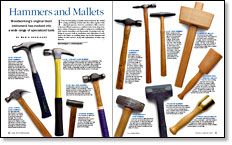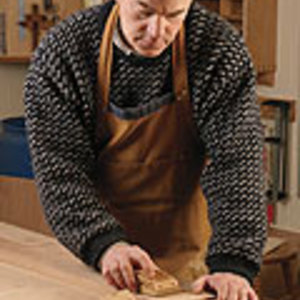All About Hammers and Mallets

Woodworkers are forever pounding, tapping, or adjusting something, or so it seems. There are nails to drive, plane irons to set, furniture to assemble, and dovetails to chop. And for all of these jobs, there is at least one specially designed hammer or mallet.
What Counts:
• Material and weight of head
• Shape of striking surfaces
• Tool balance and feel
A hammer for every nail
Many hammers are described by the weight of the head, in ounces, and may come with metal, wood or composition handles. Carpenter’s hammers have straight or curved claws for removing nails and light demolition work and run from 12 oz. for very light work to 28 oz. or more for framing houses. The heads are designed to strike only mild steel nails, not hardened nails or another hammer face. Old-style hammers have handles made from wood. Newer versions might have a fiberglass handle or be made of a single piece of steel in which head and handle are one.
A type of light hammer for driving small nails or general shop use is a cross-pein or Warrington hammer. The head has two striking surfaces — one round and one thinner and tapered that’s handy for starting very small nails without bashing your fingers or denting the workpiece. Tack hammers are very light and can be used for many things other than starting carpet tacks. Ball pein hammers are a machinist’s tool, made to work on metal. Their heads have one ordinary striking surface and one with a rounded face for forming metal curves.
Mallets are for handwork and assembling furniture parts
Wood mallets come in several styles. Large, hammer-like mallets made from a dense hardwood like beech or maple are good for heavy work. A carver’s mallet is a smaller, turned tool, usually all wood but sometimes capped with a brass head. Because the head is round, it doesn’t matter which part of it is used to strike the tool.
Rubber mallets and deadblow hammers are good for coaxing things together without marring soft surfaces. A deadblow has a rubber or urethane shell that contains lead shot. It delivers a strong blow without bouncing off the surface.
Fine Woodworking Recommended Products

Stanley Powerlock 16-ft. tape measure

Suizan Japanese Pull Saw

Veritas Micro-Adjust Wheel Marking Gauge























Log in or create an account to post a comment.
Sign up Log in